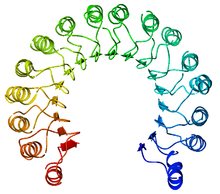Leucine-rich repeat
A leucine-rich repeat (English for "leucine-rich repeat", LRR motif) is a structural motif in a protein that contains several leucines and forms an α / β horseshoe fold . Proteins with a leucine-rich repeat are called LRR proteins .
properties
The LRR motif consists of an amino acid sequence of approximately 20-29 amino acids . In the folded state it contains secondary structures of the type β-strand - β-loop - α-helix . The areas facing outwards (parts of the α-helix and the β-loop) often contain hydrophilic amino acids, while the areas facing each other contain more leucine and are hydrophobic . Several LRR motifs can become a as leucine-rich repeat domain designated solenoid- protein domain assemble.
The LRR motif is involved in various protein-protein interactions , e.g. B. in the development of nerve cells and in the defense of plants against infection . LRR motifs are often surrounded on both sides by cysteine- rich sequences. LRR proteins in nerve cells are z. B. Densin-180 , Erbin , NGL , SALM and LGI1 .
LRR motifs are found in over 140 human proteins.
Individual evidence
- ↑ B. Kobe, J. Deisenhofer: The leucine-rich repeat: a versatile binding motif. In: Trends in Biochemical Sciences . Volume 19, Number 10, October 1994, pp. 415-421, PMID 7817399 .
- ↑ a b J. Ko, E. Kim: Leucine-rich repeat proteins of synapses. In: Journal of neuroscience research. Volume 85, Number 13, October 2007, pp. 2824-2832, doi : 10.1002 / jnr.21306 , PMID 17471552 .
- ↑ B. Kobe, AV Kajava: The leucine-rich repeat as a protein recognition motif. In: Current opinion in structural biology. Volume 11, Number 6, December 2001, pp. 725-732, PMID 11751054 .
- ^ J. de Wit, W. Hong, L. Luo, A. Ghosh: Role of leucine-rich repeat proteins in the development and function of neural circuits. In: Annual review of cell and developmental biology. Volume 27, 2011, pp. 697-729, doi : 10.1146 / annurev-cellbio-092910-154111 , PMID 21740233 .
- ^ V. Nicaise: Crop immunity against viruses: outcomes and future challenges. In: Frontiers in plant science. Volume 5, 2014, p. 660, doi : 10.3389 / fpls.2014.00660 , PMID 25484888 , PMC 4240047 (free full text).

